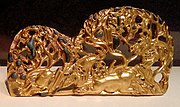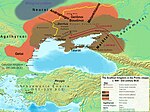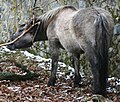reflect the influence of many cultures to the south of the steppes as well as steppes art. The six burials come from the early 1st century AD (a coin...
50 KB (5,835 words) - 19:57, 17 September 2024
Scythians (redirect from Scythian kingdom in the Pontic steppe)
the Scythian kingdom of the steppes, and the Scythian kings' headquarters were instead located in the Ciscaucasian steppes. During the peak of the Scythians'...
439 KB (53,521 words) - 12:42, 17 October 2024
steppes and connected eastern Europe to northeastern China. The Eurasian Steppe has a wide and plane topography, and a unique ecosystem. The Steppe Route...
30 KB (3,703 words) - 18:26, 27 September 2023
Véronique Schiltz (category Members of the Académie des Inscriptions et Belles-Lettres)
was a French archaeologist, historian of art, and literary translator. She was a specialist in steppes art, in particular that of the Scythians, concentrating...
11 KB (945 words) - 03:37, 25 January 2024
art encompasses the arts of the Indian subcontinent, while Central Asian art primarily consists of works by the Turkic peoples of the Eurasian Steppe...
99 KB (10,789 words) - 00:45, 4 September 2024
allowed the steppe nomads to move into the steppes proper. In these favourable climatic conditions grass grew abundantly on the treeless steppe and permitted...
18 KB (2,014 words) - 04:07, 7 October 2024
Chevauchée des steppes (2001) Carnets de Steppes : à cheval à travers l'Asie centrale (2002) L'Axe du loup : de la Sibérie à l'Inde, sur les pas des évadés...
16 KB (1,679 words) - 00:28, 24 September 2024
important works being Histoire des croisades et du royaume franc de Jérusalem (1934–1936) and The Empire of the Steppes: A History of Central Asia (1939)...
10 KB (1,124 words) - 20:00, 16 August 2024
The Empire of the Steppes: A History of Central Asia is a 1939 book written by French historian René Grousset covering the history of Central Asia from...
6 KB (630 words) - 08:32, 31 December 2023
century BCE: the rider wears the steppe dress, his hair is tied into a hairbun characteristic of the oriental steppes (as also seen in the Boar hunter)...
16 KB (1,868 words) - 00:27, 16 September 2024
necessarily mean that horses were first domesticated in the steppes, but the horse-hunters of the steppes certainly pursued wild horses more than in any other...
87 KB (8,953 words) - 19:15, 25 September 2024
for his symphonies, his two string quartets, the symphonic poem In the Steppes of Central Asia and his opera Prince Igor. A doctor and chemist by profession...
25 KB (2,686 words) - 03:54, 14 July 2024
Chinese art Chinese art is visual art that originated in or is practiced in China, Greater China or by Chinese artists. Art created by Chinese residing...
125 KB (14,379 words) - 16:20, 16 August 2024
Art of Mathura The Art of Mathura refers to a particular school of Indian art, almost entirely surviving in the form of sculpture, starting in the 2nd...
176 KB (17,473 words) - 23:57, 28 September 2024
Ciscaucasian Steppes. Like the nomads of the Chernogorovka-Novocherkassk complex, the Scythians originated in Central Asia in the steppes corresponding...
169 KB (20,507 words) - 23:44, 15 October 2024
Museum. The art of the Saka was of a similar styles as other Iranian peoples of the steppes, which is referred to collectively as Scythian art. In 2001,...
122 KB (12,639 words) - 20:17, 1 September 2024
The Nazi regime in Germany actively promoted and censored forms of art between 1933 and 1945. Upon becoming dictator in 1933, Adolf Hitler gave his personal...
85 KB (10,001 words) - 07:24, 13 September 2024
water shortages and ecological changes in both the Eurasian steppes and south Asia. At the steppes, humidization led to a change of vegetation, triggering...
267 KB (29,484 words) - 22:31, 9 October 2024
Hermitage Museum (category Art museums and galleries in Saint Petersburg)
southwest corner of the Winter Palace, features jewellery from the Pontic steppes, Caucasus and Asia, in particular Scythian and Sarmatian gold. Pavilion...
64 KB (6,398 words) - 11:20, 11 October 2024
Amazons (section Amazons in art)
place ranged from provinces in Asia Minor (Lycia, Caria, etc.) to the steppes around the Black Sea, or even Libya (Libyan Amazon). However, authors most...
74 KB (7,769 words) - 01:51, 9 October 2024
art generally reflects an interaction between other Buddhist influences and a strongly original Korean culture. Additionally, the art of the steppes,...
79 KB (9,385 words) - 20:20, 14 August 2024
pushpa,意为金色的花朵)的库车王向隋场帝表示归顺。" in Grousset, René. 草原帝国 (L'Empire des Steppes). p. 138. Rowland, Benjamin (1975). The art of Central Asia. New York, Crown. p. 151. "王屈支种也"...
73 KB (8,307 words) - 13:04, 4 October 2024
elements originating from West Asia, the Caucasus, the Southern Russian steppes and the local Central European cultures can be traced alongside each other"...
99 KB (11,842 words) - 13:48, 7 October 2024
Maykop culture (section Art)
arsenical copper. Wheeled vehicles might have entered the steppes through Maikop, revolutionizing steppe economies and making Yamnaya pastoral nomadism possible...
22 KB (2,607 words) - 19:48, 28 September 2024
R*/R1b paternal lineages that are linked to the massive migration from the steppes and dated to the Late Neolithic-to-Bronze Age transition (Haak et al.,...
45 KB (4,481 words) - 11:28, 17 October 2024
carvers began to make imitation designs of the steppes, adopting the Scythian-style animal art of the steppes (depictions of animals locked in combat). This...
118 KB (13,664 words) - 06:21, 7 October 2024
(2002). Nomadic Art of the Eastern Eurasian Steppes: The Eugene V. Thaw and Other Notable New York Collections. Metropolitan Museum of Art. pp. 24–25. Komissarov...
79 KB (9,021 words) - 19:05, 6 October 2024
Mongolie, cosmologie des pasteurs, chasseurs et guerriers des steppes du Ier millénaire avant notre ère. International Newsletter on Rock Art, Editor Dr Jean...
81 KB (9,909 words) - 11:47, 12 October 2024




























